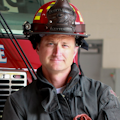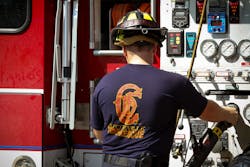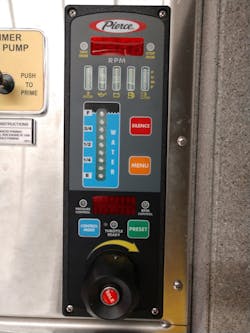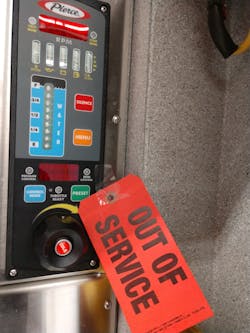At the Pump Panel: Using the Preset for Maximum Fire Flow Efficiency
Firefighters might not agree on the tactic on how to apply water to a fire, but they all agree that water puts out the fire. Furthermore, one of the first keys to fireground efficiency is getting a handline into the proper place quickly and to be ready for a quick application of water. Thus, the driver/operator must take full advantage of all resources to support the efforts of the company to get the initial line into place.
One of the easiest ways to accomplish this goal is to utilize the preset button on the pump panel. Some apparatus provide a preset option for multiple outlets. Other apparatus have a single pressure when you select the preset. In the event that the apparatus only is equipped with a single preset, the pressure must be calibrated to the most-used line. In cases in which companies pull a different line, the preset allows the apparatus to get into the neighborhood of the proper pressure, and the driver/operator can fine-tune the pressures after that.
The preset advantage
The preset allows driver/operators to utilize their senses and to continue a forward path. For example, in 2005, the Cottleville Fire Protection District of St. Charles County, MO (my organization), changed to pumpers that include a preset button. As a firefighter who served as a driver/operator, I found myself more versatile by using the preset setting, particularly in support of a three-person engine company.
As the first-due driver/operator, I placed my truck into pump, stepped outside, opened the tank to pump, opened the recirculating valve and then hit the preset button. I then walked to the rear duals to place the wheel chocks. While I walked, I listened to hear the truck idle up. If the truck idled up, I knew that everything was good, and I helped the firefighter get the hose off of the truck and into position. If the truck didn’t idle up, I knew that there was an issue and that I needed to return to the panel. The issue is resolved quickly by looking at the pressure governor panel to see one of two messages: Lo-Supply means that the pump must be primed; Comms means that the driver/operator must return to the cab to redo putting the pump into gear. These are relatively low-order failures, and a properly trained driver/operator knows how to quickly overcome these obstacles.
Detractors might cite safety concerns and state that the driver/operator can fill the line too quickly and cause a water hammer or flip the nozzle. However, this would exist if additional lines were advanced off of the apparatus once the first line is established.
Of course, take care of training issues on the training ground, with the goal of maximum efficiency on the fireground.
Also, by utilizing the preset, the truck automatically supplies the proper pre-established pressure to the handline. No time is required for the driver/operator to adjust the throttle. (Adjusting the throttle requires a coordinated effort between the nozzle firefighter and the driver/operator.) The nozzle firefighter must be flowing the handline continuously until the driver/operator gets the apparatus throttled up and the pressure set. In addition to consuming time, throttling up and setting the pressure potentially wastes water. Time and water aren’t in abundance on the fireground.
Proper discharge pressures
The efficiency of modern apparatus and fire hose has refined the friction-loss game.
Departments should perform friction-loss calculation on all pre-established hose configurations that are on the apparatus: You must recognize that friction-loss is theoretical until you test every outlet that’s on every apparatus that’s in the department.
Several factors can influence friction-loss in a pump and hoseline configuration.
Modern fire hose is engineered to reduce friction-loss. Many manufacturers have several models of hose within a hose size. Each model has a different friction-loss.
The preset should be calibrated to pump at the proper pressure, and that will be based on the flow-testing of an apparatus, with its hose and nozzle accomplishing the proper discharge gallonage, nozzle pressure and nozzle reaction.
A driver/operator training program must include the ideal pumping pressure for each pre-connected outlet that’s on the apparatus. Once a comprehensive friction-loss/pump-pressure evaluation is conducted, a chart can be built. The chart then can serve as a reference point in the event that hoselines on the fireground must be extended beyond the standard configuration. This isn’t meant to take away from the art of friction-loss calculations, but, the fact is, the next generation of firefighter is technology-based. It’s time that the fire service embraces algorithms over acronyms. It’s time that the fire service embraces apps and cheat sheets.
Button down methods
The goal of the first-arriving company is to get water onto the fire quickly. The driver/operator fills a key role in accomplishing this goal. The preset button is a resource that can assist the driver/operator in accomplishing this goal efficiently.
Preset Doesn’t Replace Training
The use of the preset isn’t meant to replace a solid training program. Organizations should set the expectation that driver/operators should know the proper pumping pressure for each standard hose deployment. A comprehensive driver/operator program should train the driver/operator to understand pumping principle: The fire service needs more than button-pushers and lever-pullers.
Some argue that to allow driver/operators to utilize the preset button is to provide a “cheat code” and that the driver/operator won’t know proper operating pressures. The fear is that the preset button allows firefighters to rely on technology rather than on knowledge. The bottom line is that the driver/operator must know the basics of the job to overcome fireground obstacles and challenges. Firefighters’ lives depend on this.
Training issues must be fixed on the training ground. Fireground efficiency can’t be sacrificed in an attempt to control a training issue.
About the Author

Brian Gettemeier
Brian S. Gettemeier has been in the fire service for 31 years, the past 28 years as a career firefighter with the Cottleville Fire Protection District of St. Charles County, MO, where he serves as an engine company captain. He is a member of St. Louis Metro Urban Search and Rescue Task Force 1. Gettemeier is a second-generation firefighter. He has a bachelor’s degree in fire service management from Southern Illinois University and holds numerous state certifications. Gettemeier teaches all-hazard classes for numerous municipal and industrial organizations throughout the states of Missouri and Illinois. He presented at Firehouse Expo multiple times.



